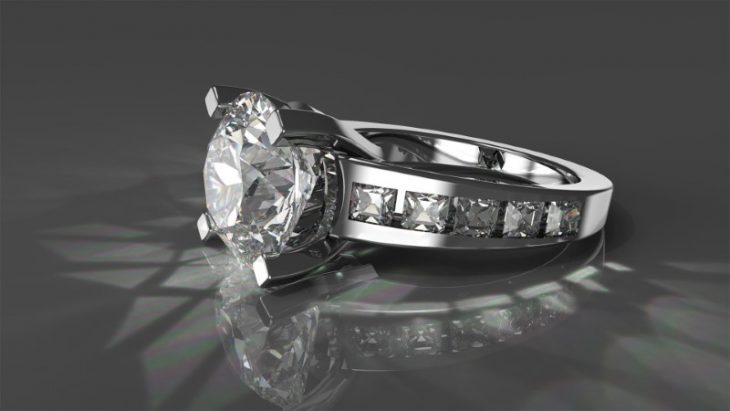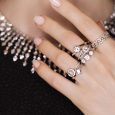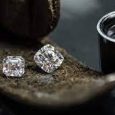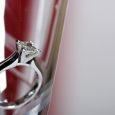FRACTURE OR CAVITY FILLING

In order to produce the amount of diamond products in demand today and to offer beautiful looking diamonds, manufacturers are employing 21st century technology to deliver gorgeous diamonds that consumers want, and all at attractive pricings. Now consumers know what a beautiful diamond looks like, and thanks to the internet they understand what a high-grade diamond with good clarity and color also costs. Actually, it’s outside most people’s reach. The average consumer cannot spend $50-thousand dollars or more on a diamond engagement ring even though they see the beauty of it and may envy a woman wearing such a dazzler.
This is the marvel of modern technology. Today, shoppers can select diamonds that are gorgeous and also within their budget. How do they do that? Technology. There are many different ways to improve a diamonds’ beauty, color, and clarity —making it much more salable in the retail setting and of course desirable to the shopper.
While there are many methods of treating (or called enhancing) a diamond to improve its attractiveness, two of the procedures are what we will focus on here. The first one is fracture filling of a diamond. That has been successfully done for a couple decades now. The second one is also very interesting. And it’s called Deep Boiling. We’ll discover the difference between the two procedures, and what each one has to offer—because the methodology and the result are very different from one another.
We must learn both the process for each procedure – like how it is done, and also what this method was intended to solve.
This is what fracture filling resolves for diamonds that are good quality other than their naturally occurring inclusions (also called blemishes or flaws); filling these surface-reaching fractures or cavities with a glass-lie material, a resin, or in some cases a type of wax or oil conceals the fracture’s visibility by making them seem to disappear. This process improves the “apparent” (the visual impression made) clarity of both diamonds and other gem materials. So, the appearance, their stability is greatly improved. And in a few extreme cases—the fillings add a slight amount of weight to the treated gem. These filling materials vary depending on the laboratory and the company doing the treatment. So, they can range from being more of a solid (a type of glass with a close RI to the treated stone) to liquids or oils. In most cases, they are colorless for certain in the case of colorless diamonds. But since this process is also being used for colored gemstones, there are instances where the filler is colored like the stone being treated. Colored filler-materials could be classified as dyes too. In the case of emeralds for example, a green filler has been routinely used to fill in the fractures –and with surprisingly good results.
Amla Cloony’s engagement ring–a clear, natural gem.
Let’s look at the most commonly encountered
fracture-filled gems being treated today
Diamond – This stone is widely treated with this process. The surface-reaching
fractures—those which extend out from the interior to the outside of the stone,
are sometimes filled with a high-lead-content glass material. This is done specifically
in order to reduce any visibility of the fractures. Here the goal of enhancing
the appearance of the diamond by obscuring the natural fractures with a filling
is a very effective way to improve its beauty. Of course, the filled fractures are
still present in the crystal. What has changed however, is the appearance of
these fractures to the unaided eye. When done expertly, these filled fractured
can even be difficult to recognize for jewelers using viewing instruments.
Ruby (Corundum)– Rubies are notorious for their naturally occurring fractures. Some are so fracture prone that they were unsalable up to a few years ago. With rubies, their numerous surface-reaching inclusions are expertly filled with a glass-like material in a molten semi-fluid state to reduce their visibility thus making the gem more of a transparent stone than it really is. In some cases, however, the amount of filler-glass can be so significant in a treated ruby that it is debatable that they should still be classified as ‘gemstone’.
Emerald (Beryl) – There are many varieties of the species beryl. All have their fans—like aquamarine for instance. But in the case of the verdant emerald, which is so often included, there needs to be a treatment that beautifies the stone so that there is more product on the market to supply the great customer demand. Surface-reaching blemishes (fractures) in emerald are routinely filled with one of several tried and true products: essential oils, or other oils for the most part. But waxes, and non-natural resins like epoxy prepolymers, other prepolymers (like the UV-setting adhesives for example), and polymers can be applied to diminish the conspicuousness of these natural fractures while at the same time improving their apparent clarity. These substances it must be said, have varying gradations of stability in the treated emeralds. Depending on the crystal treated, the quantity of a filling substance may range from insignificant to vast amounts—as much as the stone can bear without compromising its integrity.
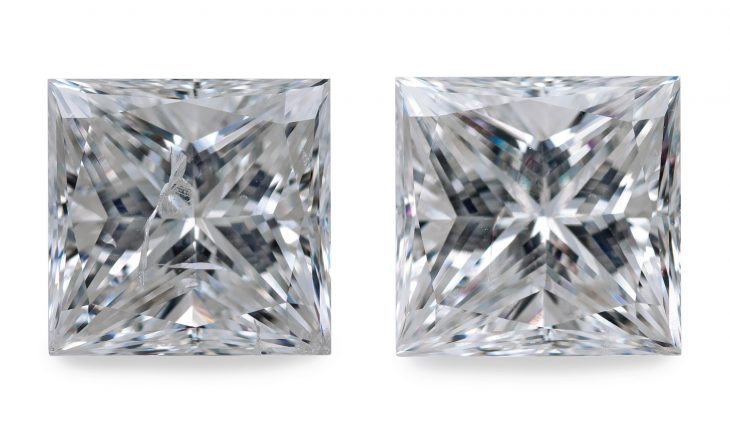
Other materials used in fracture filling for enhancement
Resins—both natural and synthetic,
and certain glasses can theoretically be used on any durable gemstone crystal
that displays surface-reaching fractures. These range from various quartz types
to topaz, aquamarine, even the colorful tourmaline and several other
transparent stones. It should be noted, however, that this method of treatment
is indeed less prevalent than the other treatment processes that are in use
commercially in large scale at this time.
Here are some considerations when discussing durability
factors –
So much of the success of the fracture filled gemstones depends on the
durability of the filler itself. For example, the glasses tend to be firmer that
their counterparts and therefore a more durable solution than resins, oils or
waxes in contrast. There are a multitude of environmental vagaries that impact
the effectiveness of enhancement treatments. For instance, changes in air
pressure, or close proximity to a heat source, or even (especially) exposure to
a range of chemicals can all adversely affect the appearance of previously filled
gems by possibly shifting or removing the filler substance entirely and
permanently. This would result in the
stone needing to undergo treatment again to refill the loss of material in the
gem.
Detectability of Fracture Filled Gemstones – Most often, fracture filled diamonds and gems can be easily distinguished by a qualified jeweler using a gemological microscope and sometimes even a simple jewelers 10X loupe.
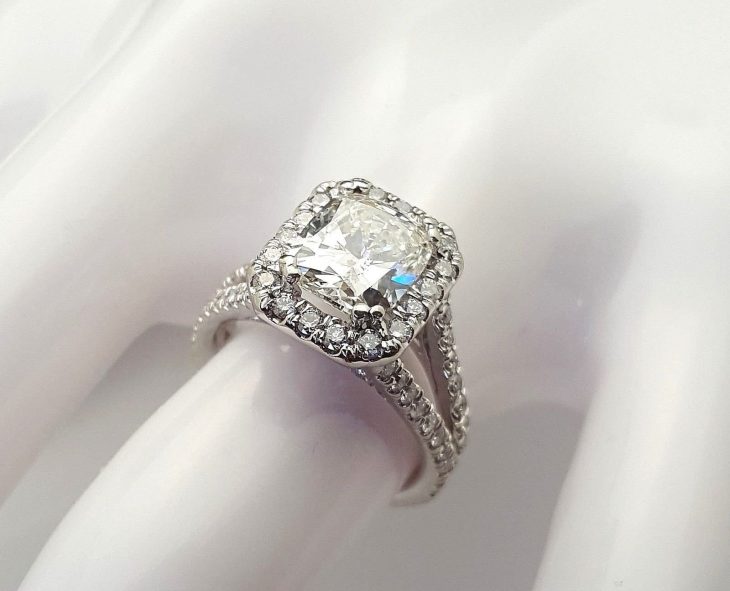
Routinely found in the trade – Fracture filling and
other technological applications for the enhancement of gemstones are prevalent
in today’s market. The most often encountered examples of filled stones are the
following; diamonds, ruby and sapphire (both corundum), and emerald.
Remember special care is required –to preserve both the
beauty and integrity of your fracture filled stone, keep the following in mind;
avoid unnecessary exposure to heat. Sudden
changes in air pressure (as in airline cabins for example) or coming in contact
with chemicals. In the case of facture filled emeralds, they can likewise
experience damage from exposure to very hot water used for washing dishes for
example.
While some early and primitive forms of fracture filling as an enhancement method applied to gems has been around for several thousand years, a diamond’s unique refractive index (often referred to simply as its RI) requires a more advanced resolution than simply wax and oil applications. This modern-day filling technology became available roughly 20 years after the time that the modern laser drilling technique for diamonds was developed.
Simply put, fracture filling in diamonds and gems creates a diminished impression in those tiny natural fractures inside diamonds—making them less visible to the naked eye or sometimes even under 10X magnification. Fractures are very common inside diamonds of course. They were created during the crystals growth phase deep within the earth’s crust. As the rough diamond travels up from the earth’s crust over a period of millions of years, through volcanic pipes it was placed under extreme stress of high heat and high pressure. and during this travel tiny fractures can form inside the diamond. If these fractures are visible This natural occurrence is damaging to the beauty of the diamond, since it somewhat reduces the sparkly capacity of a diamond. So, it will have a much lower demand due to this characteristic. Not only that, it won’t be as salable to jewelers and to consumers. When diamonds display those natural inclusions—especially in an otherwise good quality stone, this makes them excellent candidates for fracture filling which will result in visually improving the appearance of the gem.
The way the trade sees it, fracture filling of diamond (or colored stone for that matter) is often seen as the last step in a process of diamond enhancement; after a procedure of laser drilling and acid-etching of inclusions. However, if the fracture becomes surface-reaching naturally, no further drilling may be required, because there will be a natural opening to insert the filling material. This procedure, which comprises the use of specially-formulated solutions with its RI very close to that of a diamond, was pioneered by developer Zvi Yehuda who was in Ramat Gan, Israel, the diamond district near Tel Aviv. Nowadays, the name Yehuda is currently used as a brand name applied to diamonds which received treatment through his specially invented method. Sometime later, another Israeli firm, Koss & Schechter, sought to revise Yehuda’s process in the 90s with the use of halogen-based glasses, but this proved unsuccessful. The critical details inherent to the Yehuda process have been kept a secret; but the filler material used is thought to be a lead oxychloride glass, with its characteristically low melting point.

In the United States, the New York-based Dialase company also treats diamonds with a Yehuda-based procedure, which is believed to involve a lead-bismuth oxychloride glass. But research
For jewelers and gemologists trained to identify the results of this process, it is an identifiable procedure. This is due to the fact that the solution present in the fracture-filled diamonds is often quite detectable by a trained gemologist or other professional under the microscope (or jewelers loupe). While each individual diamond receives treatment that is custom fit to its unique shape, state and fracture status, still there may be trace amounts of surface-reaching bore holes (lasered by machine) and fractures associated with drilled diamonds. Additionally, air bubbles and flow lines within the glass product may be visible to the trained eye under magnification. They are features which would never be seen in natural untreated diamonds from the earth.
A more dramatic feature is the so-called flash effect, referring to the bright multi-colored flashes of color observed when a fracture-filled diamond is toggled back and forth and rotated. The colors reflected of these flashes range from an electric blue or purple to an orange or even yellow, depending on lighting conditions (light field and dark field, respectively). The flash effects are best observed with the field of view nearly parallel to the filled fracture’s plane.
In the case of strongly colored diamonds, the flash effect may be missed if the examination is less than thorough. This is because the stone’s body color will at to conceal at least one or more of the flash effects dominant hues. For example, in the brown-toned or champagne diamonds, an orange-yellow flash will likely be concealed by the stone’s body color, leaving only the blue-purple flashes to be observable.
One final but key feature of fracture-filled diamonds is to focus on the color of the filling solution itself. This material can sometimes exhibit a yellowish to brownish tinge. And along with being visible in transmitted light, it can affect the overall perceived color of the entire stone, making the diamond fall lower an entire color grade after its fracture-filling procedure. For this very reason, fracture-filling is more often only applied to stones whose size is large enough to justify the treatment. However, diamond crystals as small as .02-cts have been known to become fracture-filled.
The fracture-filling process applied to diamonds is a much-debated treatment within the diamond industry and increasingly so among the buying public today as well—while some companies do not disclose this process when selling these stones, it is actually mandated by the trade that they do so. Reputable dealers, retailers and online merchants are all happy to disclose this process to their inventory. That’s because they want their consumer to understand why their diamond prices are so attractive—at the same time producing a stunning array of diamond products. Shoppers who have be educated in the fracture filling procedure and other treatments are happy to purchase fracture filled diamonds because they understand they will get a stunningly gorgeous diamond —at a price that is well within reach. And others who compliment you on your diamond needn’t know it’s a fracture filled stone. That’s your smart secret for being such a savvy shopper.

It is important to note however, that while the fracture filling method is a durable process, some solutions can become damaged in some way, and may even melt at certain temperatures like at 1,400 °C, causing the treated diamond to “sweat” out its solution under the heat of a jeweler’s torch. Thus, any routine jewelry repair on a fracture filled diamond item can potentially lead to some degradation of clarity as a direct result of the solution loss that was used to fill the fractures — especially when the jeweler had not become aware of the treatment. So, all owners of fracture filled diamonds have a duty to inform their bench jeweler prior to him or her working (with a torch) on their piece. This a common sense safe guard to that the piece of jewelry will always remain as beautiful as the day it came from the jewelry store.
Certification of enhanced diamonds in grading reports issued from independent laboratories are an interesting topic. On the one hand, some independent gem laboratories, like the most influential Gemological Institute of America, (GIA) do not issue certificates for fracture-filled diamonds. In their estimation, since the process has the potential to lose its filling– it’s not considered permanent. Conversely, other well-known labs including EGL (European Gemological Laboratories) & GGL (Global Gem Labs) do issue grading reports on such treated diamonds–referencing their newly achieved clarity level– while also clearly indicating on the certificate that the diamond has undergone some clarity enhancement.
This is uncommon now, but an interesting fact is that a 3rd type of gem lab may be willing to certify fracture filled diamonds to their original clarity grade. This is not ideal and in fact it actually renders any treatment benefit moot by disregarding its current ungraded apparent clarity. Instead it assigns the diamond at a grade reflecting its original, un-treated clarity. It’s an interesting observation, but you can see for both retailer and consumer, it does not give any helpful documentation.

Irrespective of what kind of procedures a stone has undergone, in the marketplace today there are number of diamond which are also known as “clarity enhanced” diamonds. While there are numerous ways that the trade is able enhance a diamond’s clarity, there is only one form of enhancement has really become recognized as specifically being called “fracture filling”.
Whatever its method of treatment, in general it’s safe to say that clarity enhanced diamonds are a group of diamonds that, more than likely were diamonds that displayed eye visible (without the aid of a jeweler’s device) imperfections. In grading language, they were usually stones that were graded at I1, I2 or I3 in clarity. And because of their low-clarity grade, no one wanted a diamond with those unattractive “eye visible” inclusions. The jeweler or other professional with that stone will have had the inclusions treated so they become invisible to the naked eye. The interesting side effect is that often the treatment is so effective that the filling becomes extremely challenging even for a professional to detect. Now that’s a good result. To imagine the effect of this type of treatment—think of it as similar in concept to a cracked windshield. Many of us have experienced that in our lifetime. So, instead of replacing the entire windshield which is exorbitantly costly, the repairman opts to just “fill in the crack”. Clarity enhanced diamonds are in effect the same type of procedure; and are also known as simply being “fracture filled” diamonds. After filling procedure has been completed, the initial imperfections are diminished to the point of becoming invisible; the treated the inclusion has become completely imperceptible to the human eye.
HOW CAN I KNOW FOR SURE IF A DIAMOND HAS BEEN ENHANCED?
This is critical knowledge for the consumer and actually every retailer and reseller needs to know this too. Because this is something that the jeweler should disclose to his customer at the time of the sale. Actually, the complete disclosure should be explained prior to that point, it should be pointed out while the customer is looking at the diamond in question. Enhanced diamond merchants today are very proud of their clarity enhanced diamond inventory with good reason. The technology that delivers these sparkling clean diamonds at very attractive prices are something that the vendor can take pride in. So, in that way, he or she delivers a product that appeals to his/her market yet is completely affordable. Suppose you are shopping for a diamond. You expect to learn all about it prior to making a decision so you have the opportunity to make an informed choice; because if a deal sounds too good to be true, it just might be. That means, don’t be afraid to ask if the diamond has been treated, and if so, in what way. Many jewelers in earlier years when this technology was not widespread did not disclose treatment about their diamonds to the consumer. That is unfortunate, but for the most part, that situation is remedied today. As you know by now from reading this article, GIA does not issue lab reports for clarity enhanced diamonds. However, EGL will produce a grading report with a footnote indicating that the diamond has been enhanced.

WHO SHOULD CONSIDER A CLARITY ENHANCED DIAMOND FOR AN ENGAGEMENT RING?
The answer depends entirely on your budget, what appeals to you and other such circumstance. It’s a highly individual situation. For many couples today, clarity enhanced diamonds are exactly what they want and they are a good fit for their tastes, and budget. Many consumers buy clarity enhanced diamonds and are extremely satisfied—so much so, that they are repeat customers for when they are looking again for diamond jewelry. The ones who probably aren’t so happy are certainly those who bought them from an unscrupulous vendor who did not disclose. This amazing technology has brought more salable diamonds to the marketplace at very attractive price points today. So, there are a lot of advocates for the product. This invention has delivered less expensive, attractive sparkling diamonds to the consumer. If the treated diamond displays the other 3Cs with fine quality, then the treated diamond is win-win for everyone.
If you are a shopper looking to get the biggest carat size diamond that your budget will afford. When realizing that you just don’t have the necessary cash to pay out for an untreated high-clarity 1, 1½, or even a 2-carat diamond but still want to get your fiancée a descent looking diamond that you and she can be proud of, you should definitely consider a clarity enhanced diamond. It is nice to have the option to look at all of the diamonds in your price range even if you eventually choose against it. But one thing is for sure, the size of an untreated diamond versus a treated diamond is astounding. You will get a much larger stone for whatever you spend with choosing a treated diamond. In other types of jewelry besides the engagement ring, like diamond stud earrings for instance, opting for treated diamonds allows the shopper to buy a notably larger diamond for their money.
DOES CLARITY ENHANCEMENT TREATMENT IN DIAMONDS REDUCE THEIR VALUE?
I would say, no it does not and here’s why. Happily, you’ll see that things work to your advantage with clarity enhancement as it relates to your purchase price. If a shopper buys a clarity enhanced stone of any size, they are essentially paying for the quality that the diamond was prior to its enhancement plus some labor costs required to make it improved.
Now let’s talk about boiling the diamond.
As an alternative to fracture filling, another well-known process used in the diamond trade involves a process called boiling. Now it can be one of two sub-methods of this process. One is called Regular Boiling, and the other is referred to as Deep Boiling. At the end of the entire diamond manufacturing process, but before they are sorted to be polished, certain diamonds are earmarked to undergo one or another form of the boiling process. Basically, it involves cooking the stones in order to remove all the foreign matter that may be stuck to the diamond. The two kinds of boiling – regular and deep boiling, are also known as deep cooking.
Regular Boiling Method
For this procedure of Regular boiling, the intention is to remove any adhering external debris only. This process is conducted at various stages during the polishing process. As the polisher deems it necessary to continue the process he will have it done again. The regular boiling is performed is special rooms set up to handle this safely.
In the boiling areas, specially constructed test tubes are set up in distinct ovens, into which the designated diamonds are to be placed. If the stones are of large carat size, they are put in the ovens individually. But if the stones are smaller, they are grouped together and placed in packets. Next, sulfuric acid is poured into the test tubes along with a solution of a certain type of potassium chloride mix. Amazingly enough, diamonds are actually not affected by this acid solution, and therefore they are not harmed. The diamonds are then boiled in the sulfuric acid bath for about 15 minutes; long enough for the potassium chloride to dissolve. It is completed when the liquid turns yellow.
Now the boiled diamonds will be removed from the oven and allowed to cool. They will be washed with a large amount of water to thoroughly remove any acid residual, and then given a rinse with spirits and dried well with cloth towels. At this point the cleaned diamond is then returned to its holding container. At the very end of the entire lengthy process, the processed diamonds appear sparkling and bright, and perfectly clean from any remaining external debris.
Reviewing the Deep Boiling Process
We’ve reviewed fracture filling to discover its key role in beautifying diamonds and bringing more salable diamond inventory on the market at price points that many consumers can handle. And that’s the whole point of fracture filling and indeed any other diamond enhancement. There are so many diamonds with several good traits, however their clarity is lacking. By resolving these issues and raising the apparent clarity grade in any method whatsoever, the market has more products to offer and of course to a wider market. Many people can afford $1,500 for a gorgeous diamond but wouldn’t really be a candidate for a $5,000 diamond. And with the invention of clarity enhancement several issues are resolved for the consumer. The shopper stays within budget and is rewarded with a larger clearer diamond than they ever thought they could buy.
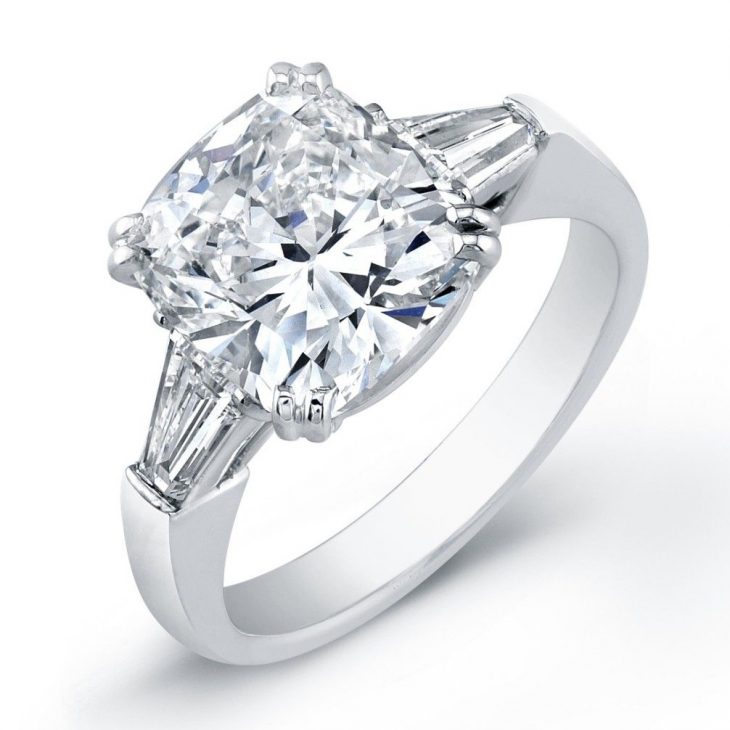
We’ve discussed fracture filling, and then regular boiling as two separate methods of improving the clarity and appearance of a diamond. Now let’s turn our attention to the 2nd phase of the boiling process with diamonds. This is referred to as deep boiling. And several suppliers believe this is the most commonly used procedure by large diamond manufacturers. But what does this process involve? And how is it different from regular boiling—in both it’s method and the reason it is employed?
The reason it seemed to be the preferred method of enhancement for large scale diamond professionals has to do with the results it delivers. It is said the treated diamonds via deep boiling display higher light reflection—which is key to a successful looking diamond that can compete with the top diamonds that haven’t been treated. Since it has this desirable effect, it can cause the diamond to emit an immense amount of light and exhibit remarkable luster. It achieves this highly desirable effect by removing dirt and a number of trace materials from several types of diamonds that display light brown –or top light brown tones. They transform into a highly coveted white and this allows the deep boiled diamonds to achieve their highest potential in appearance and value.
Deep boiling—Also called deep cooking method
The main purpose of deep boiling a diamond is to attempt to access some hard to reach areas of internal grime. It is known that the boiling solutions can often reach these impossibly difficult areas via a miniscule crack known as an open inclusion. These tiny last bits of black graphite have become trapped inside the diamond crystal and have resisted other methods of removal. These tiny specks became trapped in the diamond when it was being formed millions of years ago. And this process becomes viable since acid doesn’t corrode the crystal itself; it targets just the dirt that has become entrapped inside the stone. The strong procedure allows that dirt to be safely and effectively removed so that the finished polished diamond appears sparkling and clear.
While deep boiling is a popular solution to improving diamond’s clarity, it is also a long process that can last up to 10 to 12 hours. It is done under specialized procedures by using a mixture of extremely strong acids, all operating in conditions of extremely high heat. The diamonds to be treated are secured inside very durable containers constructed of tantalum which are then completely sealed in pressurized containers. After the boiling process is complete, the containers containing those diamonds are allowed to cool down. The remaining acid steam residue is released in order to allow the diamonds to undergo an additional regular cleaning process. The deep boiling process by contrast is more complicated and more hazardous than regular boiling as you might imagine.
The popular deep boiling process is a specific routine whose aim is to irradiate, metabolize and where needed, whiten the dark stains that are often found in crystals and hopefully which have access to an external face on the crystal. This become the point of entry for the boiling solution to reach the intended blemishes. When deep boiling is desired, its aim is to try and reach that internal dirt which was resistant to other enhancement methods including regular boiling. It is the method of choice for using these boiling materials in an attempt to reach completely inside the crystal via a tiny crack (fracture) referred to in the trade as an open inclusion. What the professionals are actually looking for is the tiny speck of black graphite (carbon) still trapped inside the stone. There may be just one visible or there could be several of these miniature dots yet trapped inside the diamond when it was in its growth phase. The deep boiling process allows that targeted dirt to be removed so the apparent clarity of the crystal will have been raised. Unlike regular boiling, the diamond given over to deep boiling is processed inside of an electric regulated furnace. While the stones are under the influence of various acids, the goal is to eventually achieve results of a brighter, clearer diamond.
So that you understand clearly the different and contrast between regular (normal) boiling and deep boiling, let’s contrast the two. They are not the same, and the professionals decide which on is the best procedure when they have inspected the rough crystals and separated them into batches for either regular boiling, or deep boiling.
When boiling is the way to go with internally cleaning a diamond to improve its clarity, then one or the other boiling methods of cleaning the diamond will be selected. In any case the diamonds being treated must be inspected at every stage of manufacturing. The critical sorting process is key in determining what defects remain after enhancement of one sort or another.
At various stages during the lengthy manufacturing process, several types of debris stick to a diamond crystal’s surface. These unwelcome added bits can be anything from traces of some sort of adhesive to dust from the polishing part, or any number of other things. When it comes to the end of the entire manufacturing process, but before they become sorted for size and quality to be polished, diamonds will now undergo the boiling process if needed. Basically, this is the so-called cooking process that eliminates all remaining foreign residue that has become stuck to the stone. As mentioned, there are two kinds of this diamond boiling method – regular boiling and then deep boiling, or what is known as deep cooking.

While fracture filling aims to fill in fractures and any cracks in the stone with a substance that makes it seem like a fracture was never there in the first place—either one of the boiling processes is a completely different technique involving cooking the stones in an acid bath to dissolve or remove the internal blemishes. Both of these technological advancements serve the end result of clearing up the diamond and thereby making it more attractive and salable. But they achieve their goals in completely different ways. Here’s what you can expect with the two separate boiling methods.
Regular diamond boiling
In this process called regular boiling, the intent is to remove the external grime only. This is directed at various stages of the diamond polishing process. As the cutter and polisher deems necessary, further scheduled processes will continue until the polisher sees the diamond has reached the desired cleanliness. Obviously with acids involved, this type of diamond boiling is conducted in specially constructed rooms with proper precautions for safety in place.
Diamond Deep boiling (deep cooking)
When it comes to tackling internal dirt in a stone, a further more intense process may be mandated. Because as contrasted to regular boiling which irradiates exterior grime, the purpose of deep boiling diamonds is to effectively reach into the center of the crystal to remove any internal dirt there. This boiling solution can actually reach deep in the stone via any tiny cracks that are surface reaching. This allows a natural entry point from the crystal exterior into the center of the stone. These types of surface reaching cracks (natural blemishes) are also known as an “open inclusion”. Any microscopic bits of naturally present black graphite that was trapped inside the diamond during its growth phase can successfully be handled in this manner. Obviously, these dark dots inside the solid diamond crystal became trapped in the diamond when it was being formed millions of years ago. The dark dots are referred to as graphite of which diamonds are actually made. Diamonds are made from just one element and that is carbon. Carbon is a type of graphite. We are familiar with graphite pencils used every day all over the world. But when time, intense heat and enormous pressure interact with carbon, it sometimes transforms into diamond—that single element gemstone. Since the acid used in deep cooking doesn’t corrode the diamond material itself– but only the dirt and grime that has entered into the stone, this remarkable process allows all debris to be successfully removed so that the final polished diamond looks remarkable clean, bright and sparkly as it should.
Consumers by now are, of course quite familiar with polished diamonds in their most brilliant form. But you’d be surprised to learn that, in the earliest stages of a diamond crystal’s journey, it was retrieved out of the ground with a far less dazzling appearance. Many people seeing a diamond in the rough would simply pass over it as another worthless pebble in the dirt. So it shouldn’t surprise you that after a diamond has been mined, it must first go through an intense cleaning process calculated to allow those rough graders to be able to see the true merits of each crystal. You can imagine that those recently mined rough diamonds are often quite dirty, being covered in residue of the kimberlite (volcanic pipeline) home they lived in for billions of years before being recovered. Additionally, there is expected abundant organic material and oxidation that was absorbed during their development as well. The entire process of cleaning diamonds is an elite combination of both art and science. This is often conducted by third party firms located in diamond centers around the world, besides being done at the mines themselves.
The challenge for diamond manufactures of course lies with cleaning rough diamonds not just to become clean on the surface of the stone, but to actually eradicate deep within the cracks of the diamond.

During both the growth of the stone, and its journey to the surface in a violent kimberlite explosion, the stone can absorb many different materials within the cracks and crevices that penetrate the middle of the diamond. This makes it very difficult to accurately see the internal quality of the stone. Properly cleaning the diamonds adds tremendous value to a rough production, likely worth more than $1 billion annually compared to selling rough as it comes from the earth.
Here’s something new for those interesting in diamond processes like fracture filling, regular boiling and deep boiling. Recently, several companies have begun working with newer cleaning technology by using microwave radiation. It’s a separate process, but obviously one that evolved from the more well-known boiling procedures. Chemicals used with this newer process however are largely the same as the more traditional boiling methods. However, instead of subjecting the diamonds to be treated to extremely high heat as is the case with traditional boiling, instead the diamonds are subjected to microwave radiation. Since it is achieved via much lower heat than required for traditional boiling procedures, with microwave application it does not often exceed 210°C. More to the point, the newer microwave method is able to achieve results in about 40 minutes, whereas it took up to an entire day previously using the traditional method. This new microwave method will eventually become an added treatment standard within the industry as more and more manufacturers adopt this time and money saving alternative.
Whatever method is used, whether it is microwave, fracture filling or one of the boiling procedures, these marvels of technology bring more beautiful diamond products to the market today—and all at very attractive prices to a very appreciative consumer. ▼
